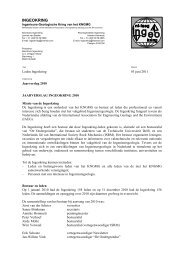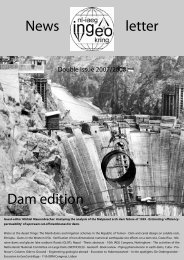environment
environment
environment
- No tags were found...
Create successful ePaper yourself
Turn your PDF publications into a flip-book with our unique Google optimized e-Paper software.
Ingeokring Newsletter<br />
ENVIRONMENT<br />
Permeable Reactive Barriers as an interesting<br />
alternative to Isolation, Maintenance and Control<br />
W.H. van der Zon & J. Maccabiani, GeoDelft, Delft, email: w.h.vanderzon@geodelft.nl<br />
Introduction<br />
Permeable reactive barriers have been the subject of<br />
research in the Netherlands, but few have actually been<br />
implemented. This short paper describes the route from<br />
research to implementation of a permeable reactive<br />
barrier.<br />
A Permeable Reactive Barrier (PRB) is a frequently used<br />
method of removing groundwater contamination in the<br />
USA and Canada [EPA 2002]. A PRB is a screen that<br />
contains or creates a reactive treatment zone that aims<br />
to intercept and remediate a contaminant plume (see<br />
figure 1). This is a way of passively remove contaminants<br />
from the groundwater by physical, chemical or biological<br />
processes. Some PRBs are installed as a permanent<br />
system and some have removable in-situ reactors which<br />
can be renewed with a cassette-like system.<br />
Case: fluorides & cyanides in a landfill leachate<br />
To give a short view of the route from research to<br />
implementation we will discuss a case in which the<br />
groundwater is contaminated with fluorides and<br />
cyanides. The problem site has been used in the 60’s<br />
and 70’s to dump both industrial as well as household<br />
waste. It was closed in the early 80’s. At present the site<br />
is in use as both a motocross racetrack and it houses<br />
the practice grounds of a rifle association.<br />
The leachate from the site contains both fluorides (in<br />
high concentrations) and cyanides. The contamination<br />
plume has to be dealt with in order to prevent further<br />
contamination of groundwater outside the site’s limits.<br />
The default approach to such a problem is a “total<br />
remediation strategy”, meaning that activities are aimed<br />
at actively removing all the contaminants from both the<br />
ground and the groundwater. This would mean however<br />
that the site cannot be used for human activities other<br />
than the clean-up for quite a while. Both present users<br />
of the site, the motocross club and the rifle club, are<br />
difficult to relocate. Therefore the current use of the<br />
site demands a special approach.<br />
The objectives to look for a new remediation strategy<br />
are:<br />
1. Present users of the site must be able to keep<br />
using it throughout the remediation. Therefore<br />
remediation must take place in situ;<br />
2. The remediation concept should take care of the<br />
existing plume, it has to be thorough;<br />
Figure 1: sketch showing the principle of groundwater<br />
cleanup using PRBs [EPA2002]<br />
3. The costs of the remediation must be lower than<br />
the conventional method of isolation,<br />
maintenance and control, “IMC” (or else this,<br />
rather expensive, strategy should be used).<br />
The idea was born to use a PRB. Since PRBs clean up<br />
contaminations in the ground water in-situ, the site can<br />
still be used for it’s present functions. The costs of<br />
PRBs are generally, and also in this case, much less<br />
than when using an IMC method. A PRB would fulfill all<br />
objectives if it could be proven that objective 2 can be<br />
fulfilled. A pilot project was then defined to investigate<br />
if a PRB can thoroughly clean the groundwater<br />
contamination.<br />
Design points of interest<br />
The design process will not be discussed here, but<br />
several important points of interest are named. For this<br />
case, the design of a PRB for this site consisted of<br />
exploring:<br />
1. the contaminated site itself, including:<br />
• assessments of the representative type of<br />
groundwater<br />
• assessments of the representative contamination<br />
(e.g. heavy metals, VOCl’s, fluorides & cyanides)<br />
2. the geotechnical boundary conditions<br />
(especially grain size distributions for the<br />
permeability profile)<br />
3. the geochemical boundary conditions (reaction<br />
rates, competing reactions)<br />
4. the geohydrological conditions, especially the<br />
14




